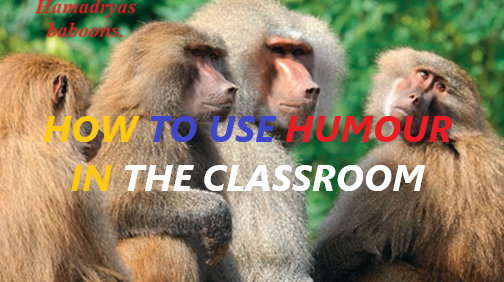10 EFFECTIVE TIPS ON HOW TO USE HUMOUR IN THE CLASSROOM.

10 EFFECTIVE TIPS ON HOW TO USE HUMOUR IN THE CLASSROOM.
Laughter is good for the soul, the mind, and the body.
We can be quite serious about our subject yet still infuse it with humor.
It is a powerful tool that can break the ice and get the listener on your side.
Humor recaptures students’ attention and anchors their memory, improving achievement.
A study found students to be more creative after listening to a humorous recording.
Humor can defuse tense situations, combat resistance, and reduce stress in the classroom.
It provides comic relief from the serious, sometimes tedious, business of learning.
Humor tends to make any experience more fun and brings a group closer together.
The cardinal rule for using humor in the classroom is that it must never be used to harm, humiliate, ridicule, or otherwise make fun of students.
Cruel, sarcastic humor is inappropriate and must not be tolerated.
Likewise, humor that is sexual or involves ethnic or gender slurs is taboo.
If you doubt as to whether an anecdote, quip, or joke is appropriate, don’t use it in school.
The safest target of humor is you.
Make a self-disparaging remark about your handwriting or stick figures drawn on the board.
Humor can be spontaneous or planned.
Some people have a natural gift for finding humor in the everyday ironies and foibles in their world. Just in the normal course of daily classroom interactions, amusing predicaments will emerge on their own.
A smile or chuckle on our part communicates that we are also human and can enjoy a good laugh, granting permission to our students to do the same.
Good-natured kidding and puns can be forms of spontaneous humor.
If you are not spontaneously witty, plan your humor by looking for cartoons, anecdotes, and quotations that you find amusing and can share with your students.
Your humorous quips or observations need not evoke knee-slapping, rip-snorting belly laughs.
Lighthearted humor that brings a twinkle to the eye, a smile to the face, or a groan or chuckle serves its purpose.
You’re not running a comedy shop.
You don’t have to be hilarious to weave humor into your class presentations.
Here are some tips on using humour in the classroom
#01
- Props, such as costumes, hats, masks, or unusual objects, can inject some levity into otherwise very serious subjects.
- Many teachers collect unusual pencils and pens.
- Accumulate inexpensive toys and puzzles with which students can spend a few minutes playing before class or during breaks.
- Some teachers convey their sense of humor through their dress and accessories.
- Colourful, funny ties, scarves, sweaters, socks, and watches are widely available.
- Use odd or funny noisemakers to signal the class to be quiet and give you, their attention.
Also read: The Pyramid of Choice and Justification.
#02
- Successful teachers develop a repertoire of stories and anecdotes illustrating various aspects of the subjects they teach.
- Some of the tales may be naturally amusing or can be made so with a bit of exaggeration, animated gestures, or surprising twists.
- Begin by drawing on funny things that have happened to you.
- Most people who believe they are not funny argue, “they can’t tell a
- If so, then don’t try to tell jokes in class (or if you do, over-rehearse it until it flows naturally).
- Jokes are probably overrated as a source of humor;
- They are the most difficult form to use successfully.
- Even a teacher who is a good joke teller should not overuse the techniques.
- If you do tell a joke, make sure it is pertinent to the topic you are teaching.
- If it bombs, you’ve at least made an academic point.
#03
- In most classes, you’ll have at least one student who will be spontaneously, genuinely witty.
- Sometimes all you have to do is play straight man to the amateur comedian.
- Such a person often enjoys the attention, so take care not to let it become disruptive or excessive.
#04
- Quotations and proverbs are another planned source of humor.
- You don’t have to be funny, just recognize what people find amusing.
- Chances are that if a quotation makes you laugh, it will also make your students laugh.
- Periodicals such as Reader’s Digest are good sources for quotations.
- Invite students to be on the lookout for ones they find funny and relevant to your subject.
- You might even designate a section of a bulletin board where they might post humorous clippings.
- Specify that they must make some point relevant to your course.
- Do remind them to stay within the bounds of good taste.
#05
- When a lesson isn’t going well, carry on a monologue with yourself in a stage whisper.
- Some teachers pick up a puppet, stuffed animal, or other object and begin talking to it.
- Pull out a picture of the person you are studying and have a chat.
- Or talk to the class goldfish or hamster.
- You can ask it questions and then answer them yourself.
- Personification, treating objects as though they were people, can be funny.
- Give your whiteboard cleaner a name and talk to it.
- Students will chuckle.
- They may lock you up, but they will chuckle.
Also read: How to Harness the Full Benefit of Discussion Method of Teaching and Learning.
#06
- When several unexpected events disrupt your class, react with humor rather than stress.
- “Well, it went better in rehearsal.”
- Suddenly shifting to an accent for emphasis gets attention.
- Or have students try doing a routine task in a different accent than normally expected.
- Intentionally slaughtering a foreign phrase (mercy bow-cup for merci beaucoup) can be amusing.
- Of course, the students need to be familiar with the phrase to recognize what you have done.
- It isn’t essential that everyone catches it, and doesn’t pause to wait for a laugh.
#07
- Insert a touch of humor into your tests, perhaps by using the name of your principal (in a tasteful way), a local celebrity, a rival school, or alluding to a current school event.
- Find a humorous poem or song to celebrate a special occasion or holiday.
- Teach it to the class.
- A humorous song related to the topic being studied can grab students’ attention and inject a touch of levity.
- This can be a good way to open a challenging or controversial subjects.
#08
- Cultivate inside jokes within your class.
- Some funny things just happen, without planning.
- They can become part of the class lore, which can be referred to from time to time throughout the year.
- Create a comedy file.
- Save in a folder or a notebook item that you might use later in your class.
- Include news items, cartoons, anecdotes, jokes, and quotations.
- As your file expands, you might categorize your items by topic.
#09
- Discover your humour style.
- Rather than forcing some brand of humour that is unnatural, experiment and rely on the kinds of humor that you already enjoy and use.
- Observe your students to see what works.
- Listen to them talking among themselves to discover what they think is funny.
#10
- Become a student of humour.
- Read the daily comics, watch funny movies, read humorous books, go to comedy clubs, and watch the good (though rare) situation comedies on
- Don’t try too hard.
- With experience, you’ll discover what kind of humor works and how much helps but does not hinder.
Join Enlighten Knowledge WhatsApp platform.
Join Enlighten Knowledge Telegram platform.






I have read a few just right stuff here. Definitely value bookmarking for revisiting. I surprise how a lot attempt you set to make the sort of wonderful informative website.
Utterly indited subject material, regards for selective information.
Simply desire to say your article is as surprising. The clarity for your publish is just spectacular and i could assume you are an expert in this subject. Well along with your permission let me to clutch your RSS feed to stay up to date with coming near near post. Thanks 1,000,000 and please continue the enjoyable work.